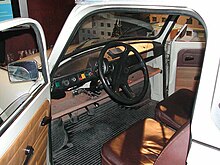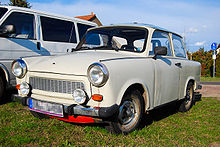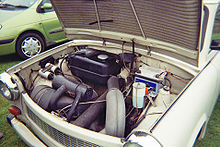Trabant
The "Scots" that wis uised in this airticle wis written bi a body that haesna a guid grip on the leid. Please mak this airticle mair better gin ye can. (Januar 2021) |
The Trabant is an automobile that wis produced bi umwhile East German auto maker VEB Sachsenring Automobilwerke Zwickau in Zwickau, Sachsen. It wis the maist common vehicle in East Germany, an wis exportit tae kintras baith inside an ootside the communist bloc an aw. The main selling pynts wis that it haed room for fower adults an luggage in a compact, licht an durable shell an that it wis fast (when introduced) an durable. Wi its mediocre performance, smoky two-stroke engine, an production shortages, the Trabant is aften cited as an ensaumple o the disadvantages o centralized plannin; on the ither haund, it is regarded wi derisive affection as a seembol o the failed umwhile East Germany an o the faw o communism (in umwhile Wast Germany, as mony East Germans streamed intae Wast Berlin an Wast Germany in thair Trabants efter the openin o the Berlin Wall in 1989). It wis in production withoot ony significant changes for nearly 30 years wi 3,096,099 Trabants produced in tot.
Overview
[eedit | eedit soorce]



The name, meanin 'satellite' in German, wis inspired bi Soviet Sputnik. The caurs ar aften referred tae as the Trabbi or Trabi, pronoonced trubbee.
Syne it coud tak years (uisual waiting time 15 years) for a Trabant tae be delivered frae the time it wis ordered, fowk who finally got ane wur very careful wi it an uisually became skillful in maintainin an repairin it. The lifespan o an average Trabant wis 28 years. Uised Trabants wad aften fetch a higher price than new anes, as the umwhile wur available immediately, while the latter required the infamous lang wait.
Thare wur fower principal variants o the Trabant, the P50, kent as the Trabant 500 an aw, produced 1957-1962; the Trabant 600, produced 1962-1964; the Trabant 601, produced 1963-1991; an the Trabant 1.1 produced 1990-1991 wi a 1043cc VW engine (makin the "1.1" a slicht misnomer). The engine for the Trabant 500, 600 an oreeginal 601 wis a smaw two-stroke engine wi twa cylinders, giein the vehicle modest performance. At the end o production in 1989 it delivered 19 kW (26 horsepouer) frae a 600 cc displacement. The caur teuk 21 seconds frae 0 tae 100 km/h (62 mph) an the tap speed wis 112 km/h (70 mph). Thare wur twa main problems wi the engine: the smoky exhaust an the pollution it produced—nine times the amount o hydrocarbons an five times the carbon monoxide emissions o the average European caur o 2007. The fuel consumption wis 7 L/100 km (40 mpg‑imp; 34 mpg‑US). Syne the engine daes na hae an ile injection seestem, twa-stroke ile haes tae be added tae the 24 litre fuel tank every time the caur wis filled up, at a 50:1 or 33:1 ratio o fuel tae ile. Gas stations o the time in kintras whaur twa-stroke engines wur common served premixed gas-ile mixture frae the pump. The day, owners normally cairy a container o twa-stroke ile in the caur for this purpose. The earlier models hae no fuel gauge; a dipstick is inserted intae the tank tae determine how much fuel remains.

The Trabant wis a steel monocoque design wi ruif, bootlid/trunklid, bonnet/huid, bumpers/fenders an doors in Duroplast, a form o plastic containing resin strengthened bi oo or cotton. This helped the GDR tae avoid expensive steel imports, but in theory did na provide much crash pertection, awtho in crash tests it allegedly performed superior tae some contemporary Wastren hatchbacks. Because the caur lacked a fuel pump, the fuel tank wis placed heich up in the engine compartment sae that fuel coud be fed tae the carburettor bi gravity; a tred-off o this design is an increased fire risk in front-end accidents. The Trabant wis the seicont caur tae uise Duroplast, efter the "pre-Trabant" P70 (Zwickau) model (1954–1959). The duroplast wis made o recycled material, cotton waste frae Soviet Union an phenol resins frae the East German dye industry, makin the Trabant the first caur wi a body made o recycled material.
| Wikimedia Commons haes media relatit tae Trabant vehicles. |
